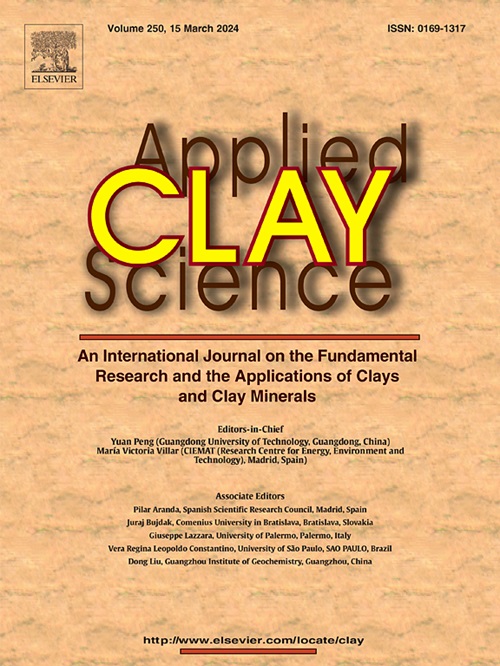滑石对鸟粪石的微生物矿化及其磷回收意义
IF 5.8
2区 地球科学
Q2 CHEMISTRY, PHYSICAL
引用次数: 0
摘要
鸟粪石微生物矿化是回收废水中氮磷的理想途径,但昂贵的镁源限制了其应用。在此背景下,我们选择希瓦氏菌MR-1作为模型微生物,研究了利用廉价而丰富的滑石作为镁源进行鸟粪石微生物矿化的可行性。结果表明,滑石能够为菌株MR-1提供镁离子,诱导鸟粪石矿化,得到的棱柱状鸟粪石纯度高达78.42质量%。随着球磨次数从0 ~ 90 min的增加,鸟粪石纯度从15.08质量%逐渐提高到51.36质量%,滑石粉的Mg转化效率从3.95%提高到20.68%。这些结果表明,机械活化可以显著提高滑石在微生物矿化过程中的反应活性。随着滑石添加量从0.2 g/L增加到2.0 g/L,鸟粪石纯度从78.42质量%逐渐降低到41.68质量%,滑石的Mg转化效率为17.54% ~ 28.02%。这些结果表明,过量的滑石不能有效地转化为鸟粪石,过量的滑石也降低了鸟粪石的纯度。溶解实验表明,培养基中的氨基酸等有机物和菌株MR-1产生的铵离子促进了滑石中镁离子的溶解。本研究加深了对微生物-矿物相互作用的认识,为富营养化水体中有机氮和有机磷的去除和回收提供了一条经济可行的途径。本文章由计算机程序翻译,如有差异,请以英文原文为准。

Microbial mineralization of struvite by using talc and its implications for phosphorus recovery
Microbial mineralization of struvite is an ideal route to recover nitrogen and phosphorus from wastewater, but expensive magnesium sources limit its application. In this context, Shewanella oneidensis MR-1 was chosen as a model microorganism to investigate the feasibility of using inexpensive and abundant talc as a magnesium source for the microbial mineralization of struvite. The results showed that talc was able to provide magnesium ions for strain MR-1 to induce struvite mineralization, producing prismatic struvite with a purity of up to 78.42 mass%. With increasing ball-milling times from 0 to 90 min, the struvite purity gradually increased from 15.08 mass% to 51.36 mass%, and Mg transformation efficiency of talc increased from 3.95 % to 20.68 %. These findings indicate that mechanical activation can significantly improve the reactivity of talc in the microbial mineralization process. With increasing talc additions from 0.2 g/L to 2.0 g/L, the struvite purity gradually decreased from 78.42 mass% to 41.68 mass%, and Mg transformation efficiency of talc ranged from 17.54 % to 28.02 %. These findings revealed that excess talc could not be effectively converted into struvite and that excess talc also reduced struvite purity. Dissolution experiments revealed that organic matter such as amino acids in the culture medium and ammonium ions produced by strain MR-1, promoted the dissolution of magnesium ions in talc. This study deepens the understanding of microbial-mineral interactions and provides an economically feasible pathway for the removal and recovery of organic nitrogen and organophosphorus in eutrophic waters.
求助全文
通过发布文献求助,成功后即可免费获取论文全文。
去求助
来源期刊

Applied Clay Science
地学-矿物学
CiteScore
10.30
自引率
10.70%
发文量
289
审稿时长
39 days
期刊介绍:
Applied Clay Science aims to be an international journal attracting high quality scientific papers on clays and clay minerals, including research papers, reviews, and technical notes. The journal covers typical subjects of Fundamental and Applied Clay Science such as:
• Synthesis and purification
• Structural, crystallographic and mineralogical properties of clays and clay minerals
• Thermal properties of clays and clay minerals
• Physico-chemical properties including i) surface and interface properties; ii) thermodynamic properties; iii) mechanical properties
• Interaction with water, with polar and apolar molecules
• Colloidal properties and rheology
• Adsorption, Intercalation, Ionic exchange
• Genesis and deposits of clay minerals
• Geology and geochemistry of clays
• Modification of clays and clay minerals properties by thermal and physical treatments
• Modification by chemical treatments with organic and inorganic molecules(organoclays, pillared clays)
• Modification by biological microorganisms. etc...
 求助内容:
求助内容: 应助结果提醒方式:
应助结果提醒方式:


